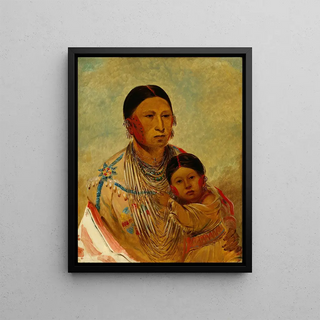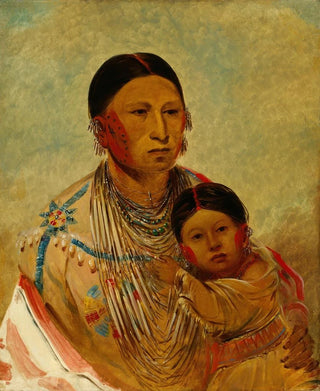Art print | Ru-Ton-Ye-Wee-Ma, the pouting pigeon woman of White Cloud - George Catlin


View from behind

Frame (optional)
In the fascinating world of Native American art, the art print "Ru-Ton-Ye-Wee-Ma, the pigeon woman of White Cloud" by George Catlin stands out for its intensity and depth. A painter and writer of the 19th century, Catlin dedicated his life to immortalizing the cultures and traditions of Indigenous peoples of North America. This iconic piece, which captures the essence of a woman from the Sioux tribe, immerses us in a world where beauty and spirituality meet. Through this representation, the artist invites us to explore the values and beliefs of a often misunderstood people, while celebrating feminine strength and grace.
Style and uniqueness of the work
Catlin's painting is characterized by a lively and expressive style, where each brushstroke seems to tell a story. In "Ru-Ton-Ye-Wee-Ma," the woman is depicted with majestic elegance, dressed in traditional garments adorned with feathers and beads. The vibrant colors and meticulous details reflect the attention given to authentic representation of the tribe's customs and rites. The woman's posture, both proud and serene, evokes an inner strength that transcends time. Catlin does not merely depict a figure; he captures the soul of a culture, offering the viewer an immersion into a rich and complex universe. This work, through its singularity, embodies not only physical beauty but also the spirit and identity of a people.
The artist and his influence
George Catlin, often considered the first artist to document the life of Native Americans, played a crucial role in preserving their cultural heritage. Born in 1796, he traveled across the United States, immersing himself in various tribes and their ways of life. His work goes beyond simple representation; it is an act of testimony and defense of Indigenous peoples' rights in the face of colonial expansion. Catlin was able to establish an authentic connection with his subjects, which is reflected in the emotional depth of his portraits.

Matte finish

View from behind

Frame (optional)
In the fascinating world of Native American art, the art print "Ru-Ton-Ye-Wee-Ma, the pigeon woman of White Cloud" by George Catlin stands out for its intensity and depth. A painter and writer of the 19th century, Catlin dedicated his life to immortalizing the cultures and traditions of Indigenous peoples of North America. This iconic piece, which captures the essence of a woman from the Sioux tribe, immerses us in a world where beauty and spirituality meet. Through this representation, the artist invites us to explore the values and beliefs of a often misunderstood people, while celebrating feminine strength and grace.
Style and uniqueness of the work
Catlin's painting is characterized by a lively and expressive style, where each brushstroke seems to tell a story. In "Ru-Ton-Ye-Wee-Ma," the woman is depicted with majestic elegance, dressed in traditional garments adorned with feathers and beads. The vibrant colors and meticulous details reflect the attention given to authentic representation of the tribe's customs and rites. The woman's posture, both proud and serene, evokes an inner strength that transcends time. Catlin does not merely depict a figure; he captures the soul of a culture, offering the viewer an immersion into a rich and complex universe. This work, through its singularity, embodies not only physical beauty but also the spirit and identity of a people.
The artist and his influence
George Catlin, often considered the first artist to document the life of Native Americans, played a crucial role in preserving their cultural heritage. Born in 1796, he traveled across the United States, immersing himself in various tribes and their ways of life. His work goes beyond simple representation; it is an act of testimony and defense of Indigenous peoples' rights in the face of colonial expansion. Catlin was able to establish an authentic connection with his subjects, which is reflected in the emotional depth of his portraits.






